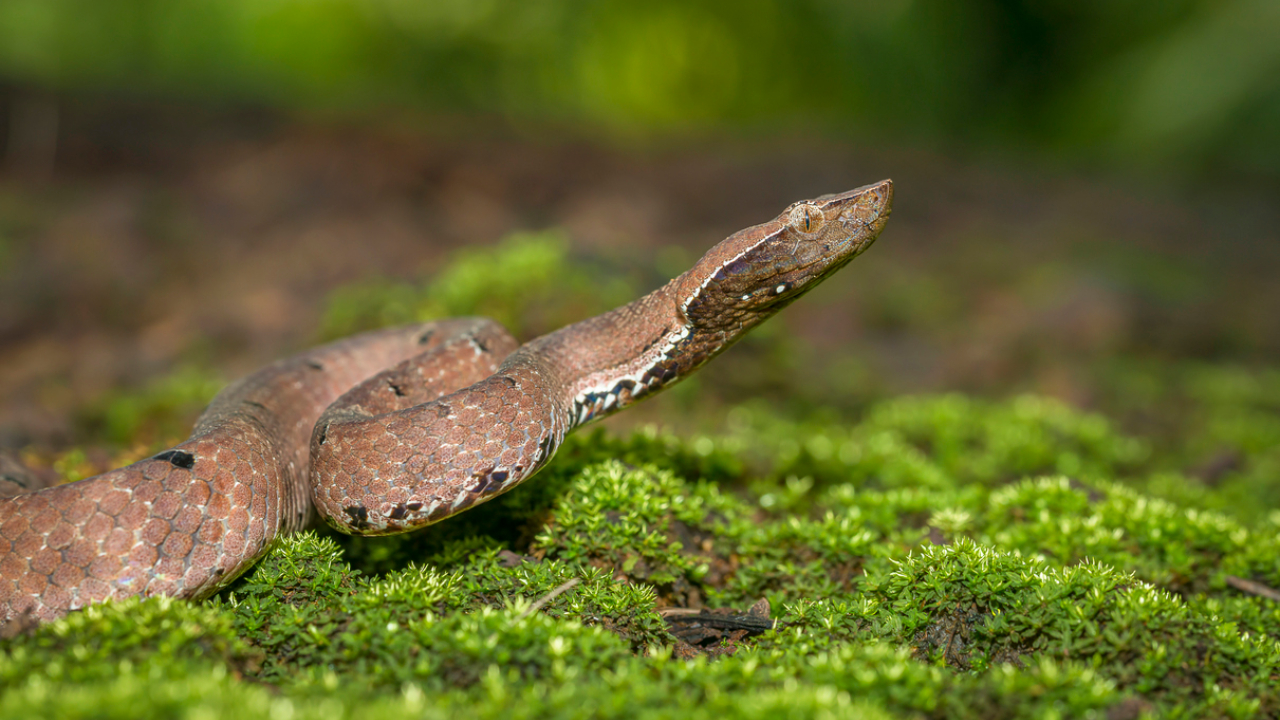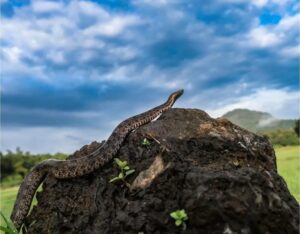Clinical studies have shown that HNPV bites can result not just in severe local effects but also in life-threatening systemic toxicity.
Published Sep 14, 2025 | 8:50 AM ⚊ Updated Sep 14, 2025 | 8:50 AM

A hump-nosed pit viper. Credit: iStock
Synopsis: Kerala faces a snakebite crisis: antivenom stocks target only the ‘Big Four’ species, offering no defense against the lethal hump-nosed pit viper, endemic to the Western Ghats and linked to acute kidney failures and deaths. The state fast-tracks region-specific antivenom research via RGCB-Forest Department collaborations. Snakebites, causing 1,114 fatalities since 2011, remain unnotified. Draft school safety guidelines, filed in High Court Sept 11, enforce audits and drills for prevention.
As the General Education Department placed its draft guidelines on school safety before the Kerala High Court on 11 September, two unsettling realities emerged – the anti-venom stocked in hospitals protects only against four common species, offering no shield against the hump-nosed pit viper and other venomous snakes endemic to the Western Ghats and snakebite is still not a notifiable disease under the state’s Public Health Act.
The state, meanwhile, has begun fast-tracking measures to address these critical gaps.
It was at a meeting convened by Chief Secretary A Jayathilak on September 1, 2025, to formulate guidelines on school safety and security—including prevention and management of snakebites—the need for antivenom (ASV) against other species emerged as a pressing concern.
The meeting further highlighted the need for intensifying efforts to tackle snakebite-related deaths by expanding its focus beyond the “Big Four” venomous snakes—Indian cobra, common krait, Russell’s viper, and saw-scaled viper.
During the meeting, the Director of the Rajiv Gandhi Centre for Biotechnology (RGCB) Professor Chandrabhas Narayan pointed out that the ASV currently available in the state is effective only against the Big Four.
The Chief Secretary further directed that a detailed study be undertaken by the Forest Department, in coordination with RGCB, to assess the necessity of producing ASV against other venomous species.
The Health Department underlined the urgency, highlighting that in addition to the Big Four, Kerala lacks ASV for the hump-nosed pit viper (Hypnale species)—a snake endemic to the biodiverse but densely populated slopes of the South-Western Ghats.
Collaborative research in this regard, officials said, would be taken forward.
The discussion is part of the broader “Snakebite Death Free Kerala Initiative”, approved by the State Biodiversity Board chaired by Chief Minister Pinarayi Vijayan on October 24, 2024.
The programme aims to halve snakebite deaths within two years and eliminate them entirely within five years.
Officials stressed that developing indigenous antivenom is an essential component, with proposals to establish a regional venom collection centre in Kerala under the Industries Department’s support.

A hump-nosed pit viper at Thattekad Bird Sanctuary. Image courtesy: Sudeesh MS Thattekkadu
Known locally as Churutta or Muzhamookhan Kuzhimandali, the hump-nosed pit viper (HNPV) is a relatively small snake, growing up to 55 cm, with newborns just 12–13 cm long. Once considered only moderately venomous, it is now recognized as highly venomous, on par with the Big Four.
Clinical studies have shown that HNPV bites can result not just in severe local effects but also in life-threatening systemic toxicity.
Victims often suffer acute kidney injury, hematological complications, microangiopathic hemolysis, and, in several cases, death.
Unusual and severe manifestations have also been reported.
Alarmingly, Kerala reports the highest number of venomous bites from HNPV, and several fatalities are attributed to it.
Despite this, no effective antivenom currently exists for the species.
The Forest Department has flagged this gap, recommending the development of either a monovalent ASV exclusively for HNPV or a polyvalent ASV covering pit vipers in general.
Research in this direction, notably by the Evolutionary Venomics Lab at the Indian Institute of Science, Bengaluru, has been supported by the Kerala Forest Department.
Officials emphasised that Kerala cannot rely solely on the pan-India polyvalent ASV, which fails against locally prevalent snakes like HNPV.
Indigenous solutions, including region-specific antivenom production, are being prioritized. “Developing antivenom beyond the Big Four is essential if we are to make Kerala truly snakebite-death free,” a senior official said.
With the state committing to a comprehensive approach—spanning research collaborations, indigenous ASV production, and targeted safety programmes in schools and communities—the long-overlooked threat of the hump-nosed pit viper is finally getting official recognition.
If successful, Kerala’s initiative could set a national precedent for tackling snakebite deaths through region-specific solutions.
Despite a directive issued by the Union Health Ministry back in November 2024 asking all states and Union Territories to declare snakebite cases and deaths as a notifiable disease, Kerala is yet to follow suit.
The issue came up in a Chief Secretary-level meeting.
The ministry had stressed that such a notification is crucial for enabling online data entry of cases, which in turn helps in generating trend analyses and heat maps for better preparedness and planning.
While the Chief Secretary pointed out that many states have already implemented the notification, Kerala has not issued one yet.
The Assistant Director of Health Services clarified that steps are underway to notify snakebite as a notifiable disease under the Public Health Act, with the draft currently under legal scrutiny.
The Chief Secretary further directed officials to expedite the process.
Meanwhile, the Forest Department suggested integrating the Health Department’s online reporting system with the SARPA mobile app, which already has provisions for recording snakebite incidents, to make planning and response more effective.
Between 2011-12 and 2025-26, as many as 1,114 people in Kerala lost their lives to snakebites, according to Forest Department data.
Startlingly, the department notes that when it comes to human-wildlife conflict fatalities, snakes — striking outside the forest — claim far more lives than elephants, tigers, or leopards ever do.
In the wake of a tragic snakebite death of a Wayanad schoolgirl in 2019, Kerala has rolled out draft guidelines mandating a comprehensive safety framework for schools.
This follows after advocate advocate Kulathur Jaisingh moved to Kerala High Court with a writ petition seeking a guideline following the death of S Shehala.
The draft guidelines thus prepared call for mandatory safety audits of infrastructure, fully equipped first-aid rooms, and at least two staff trained in life-saving skills like CPR.
Schools must conduct regular mock drills—covering emergencies from snakebites to fires, floods, and earthquakes—in consultation with disaster management authorities.
Snakebite preparedness gets special focus, with measures ranging from campus-level environmental management to awareness drives, student sessions on safe practices, and curriculum-level integration, including NCC handbooks.
Even annual safety certification will now require local body engineers to assess not just structural stability but also the safety of the surrounding premises and land.
Talking to South First, Jaisingh said, “The draft guidelines were submitted before the court on 11 September. The court will examine it. The petitioners will also examine it. Further hearing will take place on 17 September. The court on that day will comment on the draft guidelines.”
By placing snakebite management at the core of its school safety and public health agenda, Kerala has acknowledged a long-ignored threat.
The challenge now lies in turning these draft guidelines and research collaborations into actionable measures that save lives—especially from species like the hump-nosed pit viper that demand urgent, region-specific solutions.
(Edited by Amit Vasudev)
